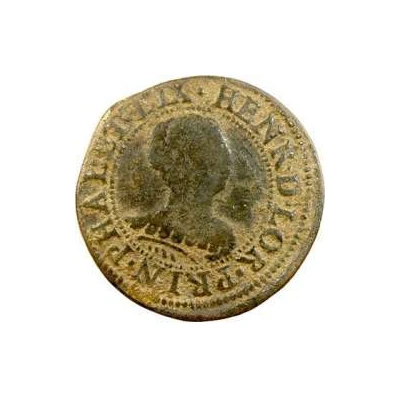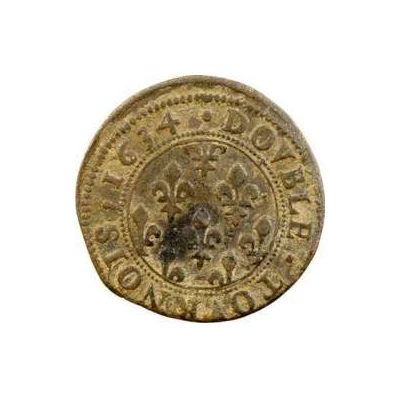


© iNumis
Double Tournois - Henriette of Lorraine 1st type
| Copper | 2.5 g | 20 mm |
| Issuer | Principality of Phalsbourg and Lixheim (French States) |
|---|---|
| Princess | Henriette of Lorraine (1629-1660) |
| Type | Standard circulation coin |
| Years | 1633-1634 |
| Value | 2 Deniers (1⁄120) |
| Currency | Livre Tournois |
| Composition | Copper |
| Weight | 2.5 g |
| Diameter | 20 mm |
| Shape | Round |
| Orientation | Coin alignment ↑↓ |
| Demonetized | Yes |
| Updated | 2024-10-04 |
| Numista | N#54193 |
|---|---|
| Rarity index | 88% |
Reverse
Value and minting year surrounding a circled fleur-de-lis field.
Script: Latin
Lettering: DOVBLE.TOVRNOIS.1634.
Edge
Plain
Comment
The letters and numbers in brackets written after all letterings are showing different varieties of the same coin listed below. Please note that different varieties contain in both side lettering the Cross of Lorraine except the C2 as the point replaces it.Obverse variants:
HENR.A.LOTH.PRIN.PHAL.ET.LIX (a)
HENR.D.LOR.PRIN.PHAL.ET.LIX (b)
HENR.D.LOR.PRIN.PHAL.ET.LIX. (c)
HENR.D.LO.PRIN.PHAL.ET.LIX (d)
Reverse variants:
DOVBLE.TOVRNOIS.1634 (1)
DOVBLE.TOVRNOIS.1634. (2)
DOVBLE.TOVRNOIS 1633 (3)
Poey d'Avant only discovered the B1 variety minted in 1633.
Henriette, sister of the Duke Charles IV, had rights to struck coins in an old mint in Lixheim. This mint mainly stroke neighbour nation imitations such as France, Lorraine (under French occupation) or Spanish Netherlands. There imitations were quickly withdrawn and denounced by the concerned territories. She also stroke "legitimate" coins in the German currency system (2 kreutzer, 24 kreutzer teston) up to the principality occupation by French and Swedish troops and the Lixheim fortress dismantlement in 1634-1635 following commands of the French king.
This doubles tournois is an imitation of the doubles tournois of Louis XIII of France.
Interesting fact
One interesting fact about the Double Tournois - Henriette of Lorraine (1st type) coin is that it was minted during a time of great economic and political change in France. The coin was issued in 1633-1634, during the reign of Louis XIII, who was attempting to centralize power and reform the French economy. The coin's minting was likely a response to the need for a more standardized and reliable currency, as the French States were experiencing economic growth and trade expansion at the time. The fact that it was made of copper, a relatively inexpensive metal, also speaks to the economic conditions of the time and the need for a coin that was accessible to a wide range of people.